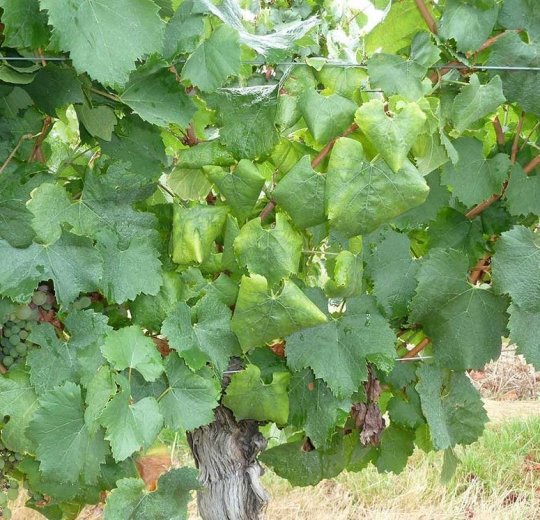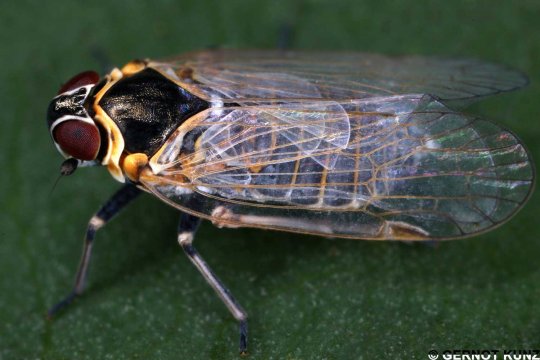Caused by the same type of infectious agent as flavescence dorée, black wood presents identical symptoms. The disease owes its name to the difficulty in lignification that it causes, resulting in wood blackening in the winter under the effect of frosts. There is sometimes semantic confusion with diseases with similar names, i.e. black foot and black dead arm, which are caused by fungi.
2.4.2.a Black wood or Stolbur phytoplasma
What damage is caused by black wood in the vineyard?
Black wood is caused by a phytoplasma, a small bacterium without cell walls in the Mollicutes class. It is a strict parasite, and relies on the metabolic activity of the cells it infects to live. It develops in the phloem conducting vessels, and causes their decay. It is transmitted by vector, a planthopper called Hyalesthes obsoletus, whose direct damage from adult bites is negligible. Symptoms observed on affected vines include:
-
A curling of the leaves towards the underside, and a hardening of the leaf blade
-
Discolouration (reddening or yellowing of the leaves depending on the colour of the grape variety), sometimes limited to the primary and secondary veins (necrosis), and which can take on a sectorial character (delimitation of large areas by the main and secondary veins).
-
Drying of stalks from the point of insertion: depending on the case, aborted inflorescences, withered, irregular and bitter berries
-
A lack of lignification, which may concern the whole vine or a part of it, or just a single branch
-
The degree of expression of these symptoms varies with grape variety. All grape varieties are susceptible or even very susceptible (Gamay, Chardonnay, Marselan, etc.), except for some varieties such as Syrah, in which symptoms are rarely observed (as for flavescence dorée)
What are the possible confusions with other diseases?
Only a molecular diagnosis (PCR genetic analysis) can differentiate between black wood and flavescence dorée (see section on Grapevine pests) since absolutely no difference can be observed in the symptoms. The incubation period of these two diseases is not precisely known (between one and three years); the appearance and intensity of symptoms depend above all on the sensitivity of the grape variety. At the epidemiological level, in the absence of preventive insecticide treatment, flavescence dorée can lead to an explosion of affected vine numbers (with an initial localized outbreak), unlike black wood where, except for occasional special cases, the diseased vines are randomly distributed among the plot. The other differences in symptoms sometimes mentioned between the two diseases (symptoms on one branch or on the whole vine, incubation period, etc.) do not correspond to any observable reality in the field when comparing symptoms and PCR analysis results.
What is its vector? Are there other means of contamination?
The black wood insect vector is a fulgoroid insect in the cixiidae family called Hyalesthes obsoletus. It is present throughout Europe and Asia Minor. It is a polyphagous insect but its main host plants are field bindweed and stinging nettles. Hyalesthes obsoletus overwinters as apterous larvae in the roots of its host plants, on which it acquires the phytoplasma. There are 5 larval stages (L1 to L5). The fifth stage larvae (L5) emerge from the soil in the spring and become winged adults that fly to other plants in search of food and sexual partners. Females lay eggs in the root crown during the summer. During their flights, the adults may land on vines and inoculate the phytoplasma. However, they do not stay alive for long, and cannot acquire the phytoplasma from an infected vine (a major difference with the epidemiology of flavescence dorée).
What is the biology of the black wood vector? How does it work?
Black wood phytoplasma is ubiquitous. It infects almost exclusively herbaceous plants. Its potential hosts are numerous: bindweed, nettles, nightshade, tobacco, lavender, mugwort, groundsel, buttercup and many solanaceous plants (tomato, bell pepper, potato, etc.). The planthopper acquires the phytoplasma by biting an already infected plant. It takes refuge in its host's intestine where it reproduces and then migrates into the haemolymph and salivary glands, where it is able to multiply significantly. The phytoplasma is not transmitted to descendants and infection of vines takes place during a flight.
Are there any preventive measures?
The best prevention consists of eliminating any reservoir plants around the plots, mainly bindweed and nettles. Transmission by grafting or propagation of infected wood is also a possible route for the spread of the disease.
The main habitat of Hyalesthes obsoletus is in uncultivated abandoned plots, ruderal areas, and border wasteland but also on grass cover for fruit crops and on weeds inside vineyards. Given the diverse habitat of Hyalesthes obsoletus, the use of insecticides is not feasible. The only recommended measure is preventive and consists of eliminating the host plants (bindweed, pepperweed, nettles etc.). It should be noted that heavy infestations have sometimes been observed (up to 50% of the vines!) on adult vines where the areas between rows or surrounding the vines were invaded by bindweed or nettles.
What treatments are available? How and when should they be applied?
The fact that the vector's reproductive cycle does not occur in vines, that its presence is accidental and fleeting, and the impossibility of acquiring the phytoplasma, make any insecticide control pointless.
Contrary to flavescence dorée, there are no compulsory measures, unless a prefectural decree is issued to organize a joint control of flavescence dorée and black wood (uprooting).
Extract from Vigne Vin Occitanie


